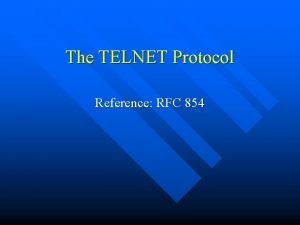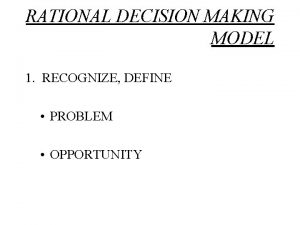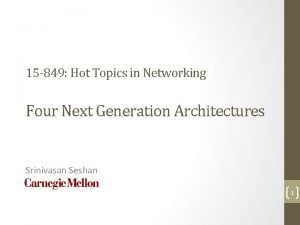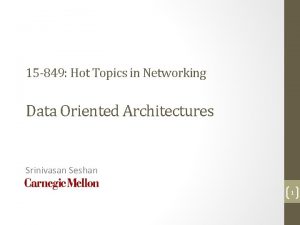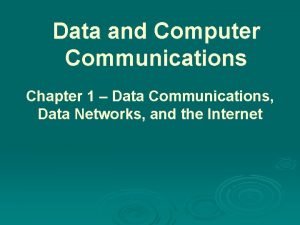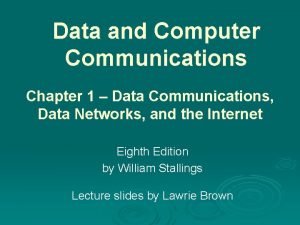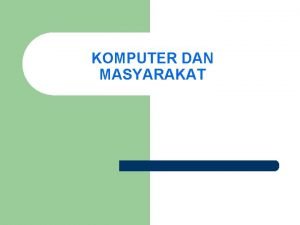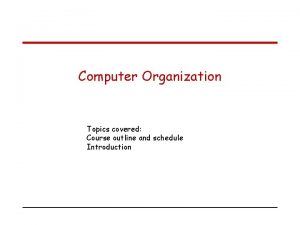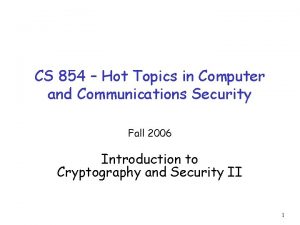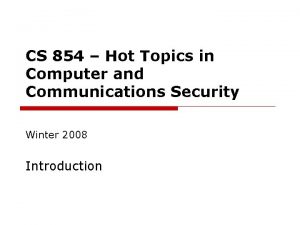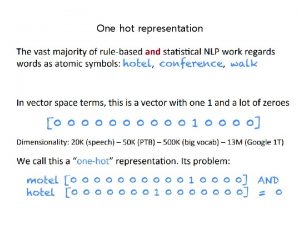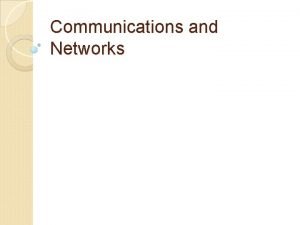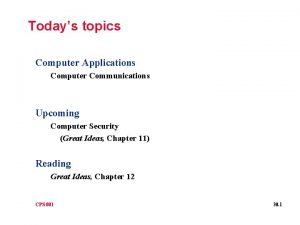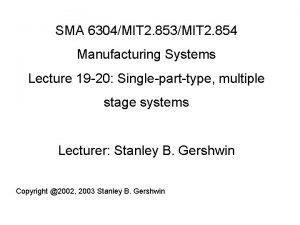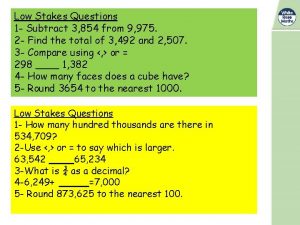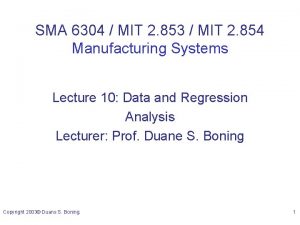CS 854 Hot Topics in Computer and Communications













![Symmetric key crypto: DES: Data Encryption Standard r US encryption standard [NIST 1993] r Symmetric key crypto: DES: Data Encryption Standard r US encryption standard [NIST 1993] r](https://slidetodoc.com/presentation_image_h2/09cc2f75d198f231823935a8ad2789da/image-14.jpg)



















- Slides: 33

CS 854 – Hot Topics in Computer and Communications Security Fall 2006 Introduction to Cryptography and Security 1

Slides r based on v Kurose & Ross, Computer networking, Chapter 8 v Stallings, Cryptography and Network Security 2

Overview r Network security r Symmetric-key encryption r Public-key encryption r Message integrity and authentication r Entity authentication r Key distribution r Computer security 3

System Model r Alice and Bob want to communicate “securely” r Trudy may intercept, delete, add, or modify messages Alice data channel secure sender Bob data, control messages secure receiver data Trudy 4

Aside: Alice & Bob r Alice wants to send a message to Bob r Eve, the eavesdropper (passive) r Mallory, the malicious attacker (active) r Trudy, the intruder (same as Mallory) 5

What is secure communication? Confidentiality: only Alice and Bob should see message contents Authentication: Alice and Bob can confirm identity of each other Message Integrity: Alice and Bob can ensure message not altered without detection Nonrepudiation: receiver can prove to third party that sender in fact sent message Traffic Analysis: Alice and Bob hide that they are communicating No Denial of Service: Alice and Bob can communicate 6

Threat Model Q: What can a “bad guy” do? A: a lot! v v v eavesdrop: passively intercept messages actively insert, modify, or delete messages into connection impersonation: can fake (spoof) source address in network packet (or any field in packet) hijacking: “take over” ongoing connection by removing sender or receiver, inserting himself in place denial of service: prevent service from being used by others (e. g. , by overloading resources) but (typically) not drop a nuclear bomb on Alice and Bob 7

Overview r Network security r Symmetric-key encryption r Public-key encryption r Message integrity and authentication r Entity authentication r Key distribution r Computer security 8

The language of cryptography Alice’s K encryption A key plaintext encryption algorithm Bob’s K decryption B key ciphertext decryption plaintext algorithm symmetric-key crypto: sender and receiver keys identical and secret public-key crypto: encryption key public, decryption key secret (private) 9

Symmetric-key cryptography KA-B plaintext message, m encryption ciphertext algorithm K (m) A-B decryption plaintext algorithm m=K A-B ( KA-B(m) ) symmetric key crypto: Bob and Alice share know same (symmetric) key: K A-B r e. g. , key is knowing substitution pattern in mono alphabetic substitution cipher r Q: how do Bob and Alice agree on key value? 10

Symmetric key cryptography substitution cipher: substituting one thing for another v monoalphabetic cipher: substitute one letter for another plaintext: abcdefghijklmnopqrstuvwxyz ciphertext: mnbvcxzasdfghjklpoiuytrewq E. g. : Plaintext: bob. i love you. alice ciphertext: nkn. s gktc wky. mgsbc Q: How hard to break this simple cipher? : q brute force (how hard? ) q other? 11

Attacks on encryption schemes Known to attacker (in addition to encryption scheme and ciphertext to be decrypted): r Ciphertext only: nothing else r Known plaintext: plaintext-ciphertext pair(s) r Chosen plaintext: plaintext(s) chosen by attacker and corresponding ciphertext(s) r Chosen ciphertext: ciphertext(s) chosen by attacker and corresponding plaintext(s) 12

Block and Stream Ciphers r Block cipher: v operates on fix-sixed blocks at a time • today’s ciphers: 128 bits reversible v plaintext and ciphertext have same size v common key sizes: 128 or 256 bit v Kerckhofs’ principle: structure of cipher is publicly known v r Stream cipher: v operates on single bit (byte) at a time 13
![Symmetric key crypto DES Data Encryption Standard r US encryption standard NIST 1993 r Symmetric key crypto: DES: Data Encryption Standard r US encryption standard [NIST 1993] r](https://slidetodoc.com/presentation_image_h2/09cc2f75d198f231823935a8ad2789da/image-14.jpg)
Symmetric key crypto: DES: Data Encryption Standard r US encryption standard [NIST 1993] r 56 -bit symmetric key, 64 -bit plaintext input r How secure is DES? DES Challenge: 56 -bit-key-encrypted phrase (“Strong cryptography makes the world a safer place”) decrypted (brute force) in 4 months (1997) v no known “backdoor” decryption approach r making DES more secure: v use three keys sequentially (3 DES) on each block v slow v 14

Symmetric key crypto: DES operation initial permutation 16 identical “rounds” of function application, each using different 48 bits of key, derived from 56 -bit key final permutation From Wikipedia 15

DES F-Function r Expansion r Key mixing r Substitution (“S-Box”) v Provides non-linearity r Permutation From Wikipedia r All of them together provide diffusion 16

AES: Advanced Encryption Standard r new (Nov. 2001) symmetric-key NIST standard, replacing DES r processes data in 128 -bit blocks r iterative, rather than Feistel cipher v v v operates on entire data block in every round decryption different from encryption efficient implementation r 128, 192, or 256 bit keys r brute force decryption (try each key) taking 1 sec on DES takes 149 trillion years for 128 -bit AES 17

AES From Stallings 18

Block Cipher Modes r Block cipher modes enable processing of messages with arbitrary length r Electronic Codebook Mode (ECB) r Don’t use ECB From Wikipedia 19

Block Cipher Modes r Cipher Block Chaining Mode (CBC) r Most widely used From Wikipedia r IV (Initialization vector) v Does not need to be kept secret v Fixed value, counter, or random? 20

Block Cipher Modes r Counter Mode (CTR) From Wikipedia r Block cipher to implement stream cipher v Encryption and decryption are identical r Never reuse key/nonce combination 21

Overview r Network security r Symmetric-key encryption r Public-key encryption r Message integrity and authentication r Entity authentication r Key distribution r Computer security 22

Public-Key Cryptography symmetric-key crypto r requires sender, receiver know shared secret key r Q: how to agree on key in first place (particularly if never “met”)? public-key cryptography r radically different approach [Diffie. Hellman 76, RSA 78] r sender, receiver do not share secret key r public encryption key known to all r private decryption key known only to receiver 23

Public key cryptography + Bob’s public B key K K plaintext message, m encryption ciphertext algorithm + K (m) B - Bob’s private B key decryption plaintext algorithm message + m = K B(K (m)) B 24

Public key encryption algorithms Requirements: 1 2 . . + need K B( ) and K - ( ) such that B - + K (K (m)) = m B B + given public key KB , it should be impossible to compute private key K B RSA: Rivest, Shamir, Adelman algorithm 25

RSA: Choosing keys 1. Choose two large prime numbers p, q such that their product has at least 1024 bits 2. Compute n = pq, z = (p-1)(q-1) 3. Choose e (with e<n) such that e, z are relatively prime. 4. Choose d such that ed-1 is exactly divisible by z. (in other words: ed mod z = 1 ). 5. Public key is (n, e). Private key is (n, d). + KB - KB 26

RSA: Encryption, decryption 0. Given (n, e) and (n, d) as computed above 1. To encrypt bit pattern, m, compute e e c = m mod n (i. e. , remainder when m is divided by n) 2. To decrypt received bit pattern, c, compute d m = c d mod n (i. e. , remainder when c is divided by n) Magic d m = (m e mod n) mod n happens! c 27

RSA: m = (m e mod n) Why is that d mod n Useful number theory result: If p, q prime and n = pq, then: y y mod (p-1)(q-1) x mod n = x mod n e (m mod n) d mod n = med mod n = m ed mod (p-1)(q-1) mod n (using number theory result above) 1 = m mod n (since we chose ed to be divisible by (p-1)(q-1) with remainder 1 ) = m 28

RSA: Security r relies on the assumption that there are no algorithms for quickly factoring n into p and q v would allow attacker to compute z=(p-1)(q-1) and d using ed mod z = 1 r but we don’t know whethere exist such fast algorithms… 29

RSA: Issues r RSA exponentiation is slow v at least 100 times slower than DES v use hybrid scheme, e. g. , • AES for encrypting actual data • RSA for encrypting corresponding AES session key r RSA can be vulnerable, e. g. , v small d or e v deterministic v timing attacks v do not use your own implementation of RSA 30

RSA: another important property The following property will be very useful later: - + B B K (K (m)) + = m = K (K (m)) B B use public key first, followed by private key use private key first, followed by public key Result is the same! 31

El Gamal r Prime p, random g (< p) r Private key: d Public key: e = gd mod p r Encryption: message m, random r c = (gr, mer) (mod p) r Decryption: c = (c 1, c 2) c 2/(c 1 d) = mer/gdr = mgdr/gdr = m r assumes that computing discrete logarithms is hard r probabilistic scheme (ciphertext > plaintext) 32

Diffie-Hellman Key Exchange r first published public-key algorithm r Alice and Bob establish joint secret even though r r r Eve is reading all the exchanged messages! assumption: public prime q, integer n Alice: Choose secret XA, compute and give YA to Bob: Choose secret XB, compute and give YB to Alice Joint secret: Also relies on discrete logarithms problem Susceptible to man-in-the-middle attack 33
 Rfc 854
Rfc 854 Virtualization
Virtualization Cs 854
Cs 854 854,917,632
854,917,632 Ntp 854
Ntp 854 Emily edison nutrition
Emily edison nutrition Hot topics in patent law
Hot topics in patent law Hot topics in networking
Hot topics in networking Hot topics in leadership
Hot topics in leadership Histology job
Histology job Hot topics in networking
Hot topics in networking Data and computer communications 10th edition
Data and computer communications 10th edition Data & computer communications
Data & computer communications Data and computer communications
Data and computer communications William stallings data and computer communications
William stallings data and computer communications White hot vs red hot temperature
White hot vs red hot temperature Cold working processes
Cold working processes Perbedaan hot lava dan hot lava volcano
Perbedaan hot lava dan hot lava volcano Hot nor hot
Hot nor hot Computer and society topics
Computer and society topics Networking standards organizations
Networking standards organizations Computer organization course
Computer organization course Advanced topics in computer science
Advanced topics in computer science Objectives of computer
Objectives of computer Difference between a computer and computer system
Difference between a computer and computer system Computer, computer basics, input and output devices
Computer, computer basics, input and output devices Computer architecture vs organization
Computer architecture vs organization Track and report nims
Track and report nims Means communication at a distance
Means communication at a distance Tactical communications
Tactical communications Global marketing and communications
Global marketing and communications Backbone network components
Backbone network components Business data communications and networking
Business data communications and networking Designing and managing marketing communications
Designing and managing marketing communications
